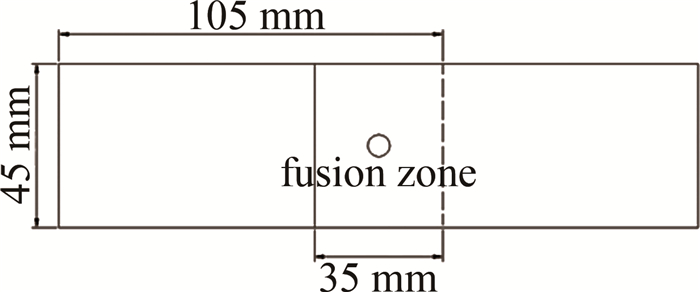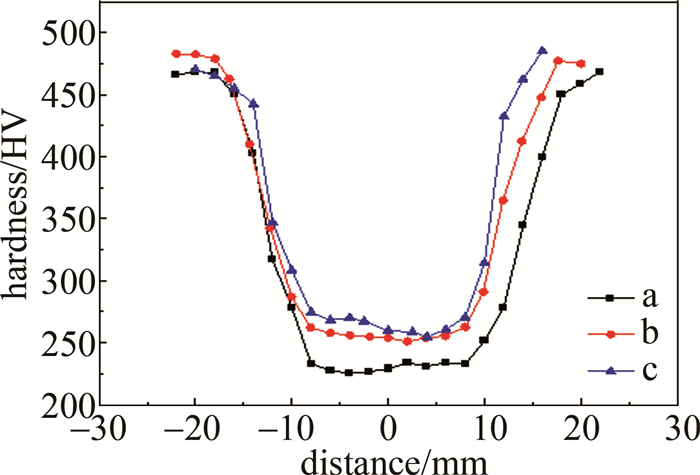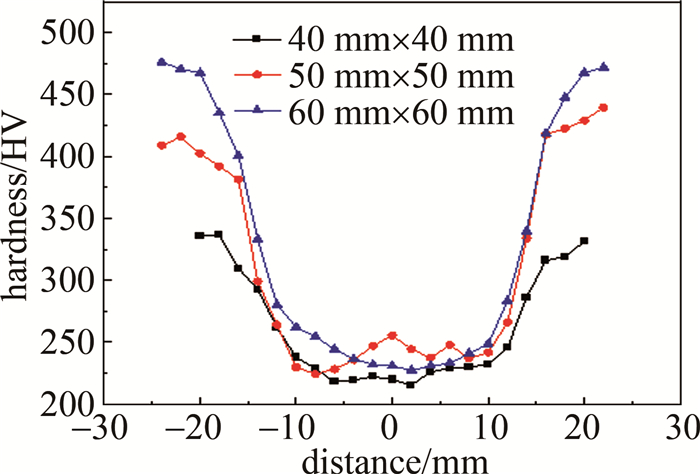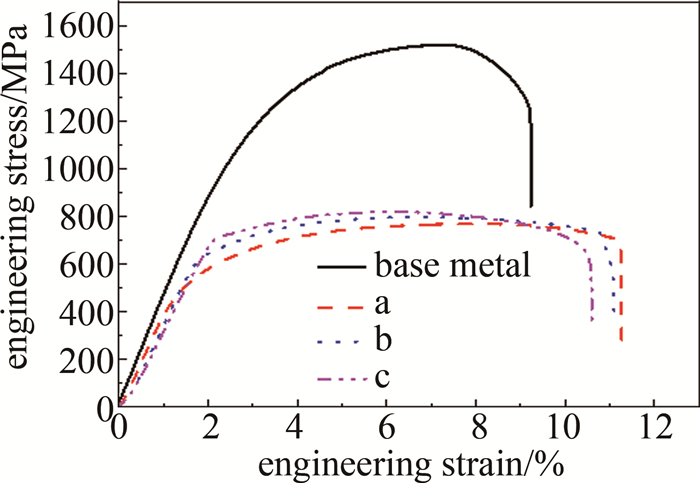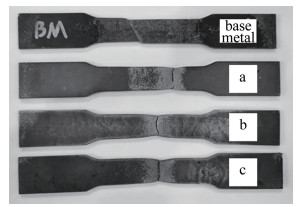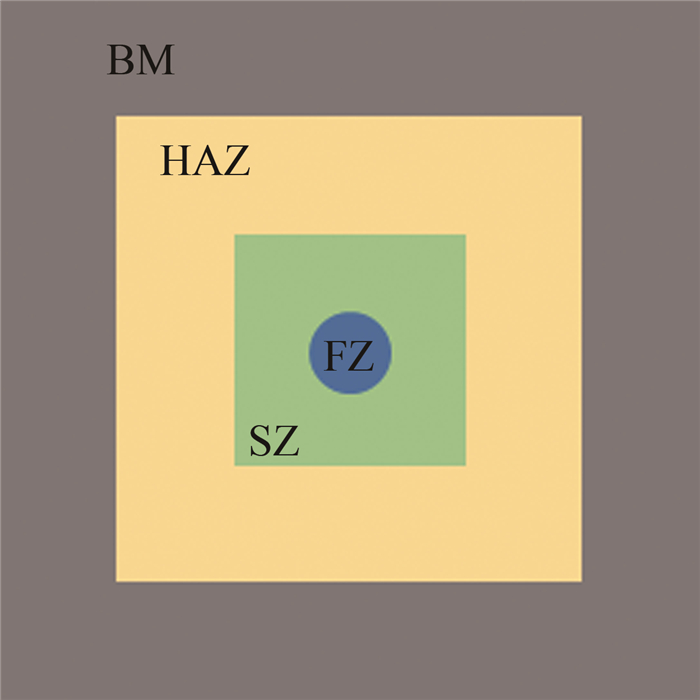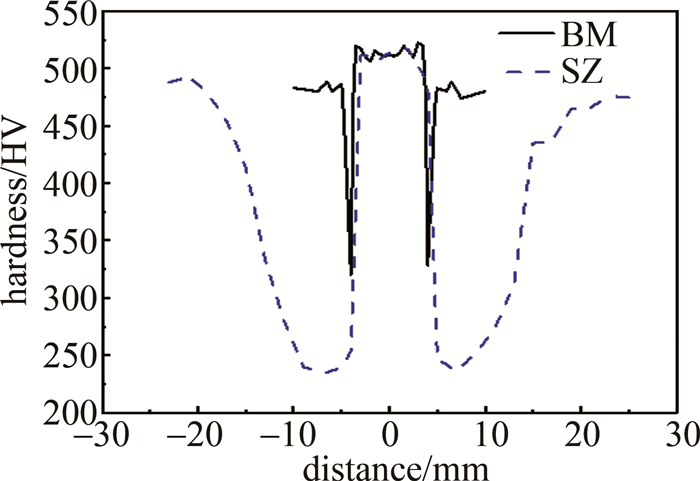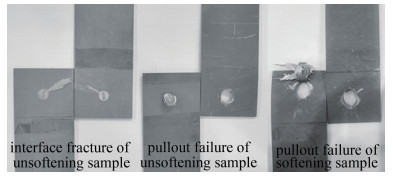HTML
-
热成形钢是一种超高强度钢(抗拉强度大于780 MPa),根据成分种类不同,其淬火后抗拉强度可达1000 MPa~2000 MPa[1]。热成形钢主要用作汽车白车身零件,由于其强度高,在减少钢板厚度的同时能保证安全性能,达到节约能源和汽车轻量化的目的[2]。研究表明,汽车重量减少10%,油车可降低6%~8%的油耗,电车可提升13.5%的续航[3]。汽车轻量化成为节能减排和降本增效的有力途径,热成形钢在白车身中应用占比逐年提高[4]。
热成形技术具有零件淬火后强度高、高温成形回弹小、成形精度高、成形载荷小、一次成形等优点[5]。然而热成形零件的抗拉强度越高,其硬度越高,塑性、韧性越低,其焊接性能越差,热影响区应力大,焊点表现脆性,受到冲击时易开裂[6-7]。热成形钢铆接时, 由于铆钉脚受到应力过大,发生变形,导致综合性能不佳[8-9]。在零件连接位置进行局部加热回火,可以消除内应力,降低硬度,提高其塑性[10]。一般采用局部感应加热、电极加热等方法进行回火,但这些方法存在灵活性差、批量生产需要额外工装、控温精度差等问题[11]。
激光软化技术将激光作为热源,对选定区域进行局部加热,降低局部区域的硬度,提高塑性,消除内应力[12-13]。激光软化技术可控性和灵活性好,通过调节激光能量功率、扫描速率、光斑大小等参量,实现不同的软化性能,结合数控机器人可以实现不同部位和软区形状大小的定制化需求[14-15]。本文中通过激光对热成形钢进行局部软化,研究激光软化工艺和软区组织的性能变化。
-
本文中所采用的原材料为退火态CR950/1300HS+AS,厚度1.8 mm,其化学成分如表 1所示。先将原材料钢板在950 ℃保温5 min完全奥氏体化,然后平板模水冷淬火并保压10 s,得到超高强钢板坯料待用。
C Si Mn P S Al B N Cr Ti Mo 0.00182 0.00862 0.0111 0.00006 ≤0.000001 0.0174 0.000026 0.000092 0.00191 0.000303 0.000049 Table 1. Chemical composition of CR950/1300HS steel (mass fraction)
激光软化设备采用TruDisk4002,波长1030 nm,发射高斯光束垂直照射钢板表面,在待软化区域按照设定路径快速移动,加热温度设定为800 ℃,实现快速高温回火效果。本文中设计软区大小为20 mm×20 mm。
本文中采用SCV-50A维氏硬度计,每隔2 mm测量试样的显微硬度,压头载荷为9.8 kg,保压时间为10 s。采用电子式万能试验机Instron 3382,拉伸速率为2 mm/min,拉伸试样尺寸如图 1所示。点焊拉伸剪切试验的试样尺寸如图 2所示。软化试样经过镶嵌、打磨、抛光后,用体积分数为4%硝酸酒精溶液腐蚀,采用DS-300金相显微镜来观察试样金相组织。
-
淬火后的原材料的金相组织如图 3所示。由于该材料中含有更多的B元素,会使得钢的淬透性提高,从而淬火后更容易获得更多的马氏体,可以看出基体组织为板条状马氏体,组织内有许多相互平行的板条束组成的马氏体块,各马氏体块之间以大角度界面分开,所以金相中各马氏体块出现黑白交替的色调。在母材表层有一厚度为35 μm~40 μm的铝硅镀层,图中镀层主要由厚度约28 μm~30 μm的Al-Si合金层和厚度约10 μm的Fe2SiAl7金属间化合层组成。由于镀层的保护作用,钢板在热成形的过程未出现氧化脱碳,基体为全马氏体组织。
热影响区和软区位置横截面的金相组织如图 4所示。随着加热温度的升高,热影响区金相主要有图 4a、图 4b、图 4c 3种,软区(中心加热区)金相为图 4d。图 4a中组织为回火马氏体,该温度状态主要处于回火第一和第二阶段,马氏体开始分解,析出ε/η过渡碳化物,其中ε相成分介于Fe2C和Fe3C之间,η相成分为Fe2C,此时分辨马氏体板条束的形状和大小,但条束边界和马氏体块角度的形态开始模糊。图 4b中组织为回火马氏体和渗碳体,该温度状态主要处于回火第三阶段,马氏体继续分解,板条束的界面消除,马氏体束取向还能分辨,析出的过渡碳化物在大角度界面处转变为渗碳体并钉扎住界面,使得板条马氏体的形态能稳定存在至很高的回火温度。图 4c中组织为铁素体和渗碳体,该温度状态主要处于回火第四阶段,由于回火时间较短,大部分铁素体仍保持条束状的外形,此时渗碳体发生粗化并逐渐球化,分布在铁素体基体中,渗碳体粗化后不能有效钉扎大角度界面,表现为界面数量减少,降低界面能,晶粒长大并形成等轴铁素体。图 4d中组织为回火索氏体,使得该区域具有较低的硬度,塑性和韧性提高[16]。回火索氏体为待软化区经过激光快速升温至800 ℃,随后空冷得到。此时的回火阶段中马氏体条束的痕迹已经消失,渗碳体数量增加且球化比较完全,表现为铁素体基体中弥散分布着大量的细粒状渗碳体,由于渗碳体弥散程度较高,金相中无法区分晶界[17-18]。
-
测试试样软区横截面厚度中心硬度,不同位置的硬度变化曲线如图 5所示。表 2为图 5中不同工艺下的实验数据。可以看出,在800 ℃下,激光扫描速率越慢,软区硬度越低,软区硬度曲线越平稳,这是因为扫描速率越慢,在加热区域内的保温时间就越长,组织扩散越充分,实际回火效果越好,得到的回火索氏体越多,其弥散性越好。热影响区随着距离中心越远,硬度越高,直至达到母材硬度范围,这与金相的结果一致,表明热影响距离越远,该区域的温度越低,该区域所处的回火阶段越低,所得到的组织硬度逐渐升高。实验中在不同的激光扫描速率下,扫描区域为20 mm×20 mm,实际软区宽度均为16 mm左右,说明在激光加热温度不变的情况下,改变激光扫描速率,主要影响了软区的硬度,实际软区宽度(16 mm)和热影响区宽度(10 mm)变化不大。
process temperature/℃ scanning direction linear speed/(mm·s-1) scan time/s average hardness of soft zone/HV a 800 2 10 230 b 800 4 5 256 c 800 10 2 265 Table 2. Laser softening process data
通过对不同尺寸大小试样的中心区域进行软化,扫描区域为20 mm×20 mm,激光工艺为800 ℃,扫描方向线速率为2 mm/s,研究非加热区域大小在软化过程中受热影响所产生的变化,测量的硬度结果如图 6所示。试样尺寸越小,软区位置最低硬度会稍微降低,硬度曲线也越平稳,这是因为小的试样尺寸冷速会较慢,相当于其回火时间越长,软区的回火后硬度会更低,组织均匀性更好。随着试样尺寸的增大,非加热区参与对软区的传热和散热体积增加,导致非加热区在受热影响后在相同的距离时材料温度相比越低,其回火阶段越低,在相同的距离有更高的硬度。试样尺寸小于60 mm×60 mm时,试样散热能力不足,整个试样软区四周均会受热影响区而硬度降低。
-
热成形钢母材和激光软化试样的拉伸工程应力应变曲线如图 7所示。拉伸性能数据如表 3所示。软化试样a、b、c(分别对应3种不同工艺)的塑性变形均发生在软化范围内,所以软化试样计算断后伸长率的原始标距采用软区宽度20 mm,这样能更真实地反映软区内的断后伸长率。母材是全马氏体组织,具有较高抗拉强度和屈服强度,但其塑性较低。由软化工艺得到的软区组织主要为回火索氏体,其抗拉强度降低至母材的50.53%~53.82%,但塑性会大幅提升,而断后伸长率为母材的172.26%~188.08%。
sample tensile strength/MPa yield strength/MPa elongation after fracture/% reduction of section/% base metal 1518 1155 9.23 23.15 a 767 488 17.36 36.16 b 798 655 16.65 34.77 c 817 723 15.90 37.74 Table 3. Tensile test data
随着扫描方向线速率的增加,软化试样抗拉强度稍微提高,与硬度提高趋势一致;激光扫描速率增加对软化试样屈服强度的影响较明显,其屈服强度提高较多,这是由于激光扫描速率加快,回火时间会缩短,回火组织扩散时间缩短,仍存在较多位错,而且渗碳体球化和弥散程度降低,还能起到钉扎作用,所以屈服强度提高;软区断后伸长率稍微下降。
母材和软化试样拉伸后的外观如图 8所示。断裂方式均为韧性断裂。母材断面类型为剪切滑移型断面,断裂面与拉伸方向成45°角,有一定的滑移现象,剪切唇占断面面积的2/3。软化试样断面类型为杯锥状断面,变形区域集中在软区内,随着应力的增大, 在软区中间出现明显颈缩现象,断面收缩率相比母材增加,由于试样较薄(厚度1.8 mm),断面只有剪切唇区[19]。
-
将两片软化试样进行搭接,制作电阻点焊拉伸剪切试样,图 9为激光软区范围和焊点位置示意图。从外向内分别为母材(base metal,BM);热影响区(heat-affected zone,HAZ);软区(softening zone,SZ);焊核区(fusion zone,FZ)。电阻点焊参数为焊点直径6.7 mm、电流8.6 kA、压力4.2 kN、焊接时间400 ms、冷却时间30 ms。
测量比较母材焊接试样、软化焊接的焊点硬度,结果如图 10所示。母材CR950/1300HS+AS正常点焊时,焊核区域硬度515 HV左右,热影响区硬度会在1 mm~2 mm内快速降低又快速升高,最低硬度320 HV。预先软化后,在软区内点焊,焊核区域硬度515 HV左右,之后受焊接热影响硬度在1 mm范围快速降低至软区硬度,再向外经过软区,然后硬度在10 mm宽度的过渡区内逐渐上升至母材硬度。通过焊接前激光软化,相比传统焊接后回火工艺,可以实现不降低焊点硬度,调节热影响区最低硬度,使热影响区宽度增加,硬度变化趋势减缓,改善热影响区的应力集中现象。
比较未软化的母材点焊拉伸剪切实验、软化试样的点焊拉伸剪切实验,结果如表 4所示。实验的位移载荷图如图 11所示。软化后试样的最大试验力相比未软化的降低,但软化后不同试样的焊点拉伸剪切曲线会更一致,且不会出现界面断裂的现象,其最大断裂位移增加60%。软化前最大吸收能量为61.92 J(见曲线2),软化后最大吸收能量为68.20 J(见曲线4),提升了10.14%。试样断裂后外观如图 12所示。可以看到,未软化的母材试样,焊接接头断裂方式包含界面断裂和熔核拔出,其中界面断裂表明裂纹在结合面扩张速度极快,接头在达到最大试验力后瞬间失效,焊点沿着两片试片结合面断裂成两半,断裂面较平整,实际应用中应该避免出现界面断裂;熔核拔出则是在达到最大试验力后,裂纹在圆形熔核最上端产生,随着拉伸进行裂纹沿着熔核圆弧向两边扩展,熔核作为一个整体逐渐从试片中拔出,直径约7.5 mm,试片中留下圆形空缺,搭接端出现变形,熔核拔出失效模式裂纹扩展缓慢,在裂纹扩展阶段焊点和基体仍保持机械连接,能通过变形的方式吸收后续载荷[20]。软化试样的焊接接头断裂方式均为熔核拔出,和母材试样不同的是其熔核会连带着部分软区一同拔出,拔出范围更大,呈椭圆形,长轴约13.5 mm。
technology thickness combination/mm number maximum test force/N unsoftening 1.8+1.8 1
2
332717
31757
32206softening 1.8+1.8 4
5
627070
27436
27645Table 4. Properties of welding spot tensile and shear
2.1. 金相组织
2.2. 软区硬度
2.3. 拉伸结果
2.4. 软区内点焊性能研究
-
(a) 通过激光加热回火,成功实现了热成形钢局部区域的定制软化。一定情况下,激光扫描速度越慢,软区硬度越低。温度为800 ℃、扫描线速率为2 mm/s时,软区组织为回火索氏体,软区硬度为230 HV,抗拉强度767 MPa,屈服强度488 MPa,断后伸长率17.36%,软化后为韧性断裂。
(b) 热成型钢激光软化后进行点焊,焊核硬度(515 HV)不变,激光软化可以调节热影响区最低硬度,增加热影响区宽度,使硬度变化趋势减缓,改善热影响区的应力集中现象。软化后试样的焊点拉伸剪切最大试验力相比未软化的降低,但软化后试样的焊点拉伸剪切曲线会更一致,且不会出现界面断裂的现象,均为熔核拔出,其最大断裂位移增加60%,最大能量吸收功提升了10.14%。

 Map
Map




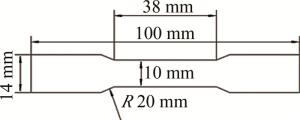
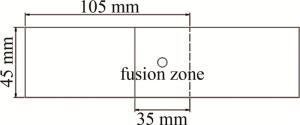
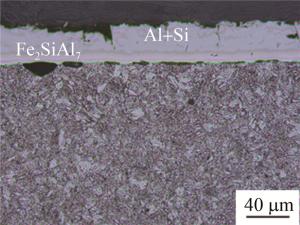
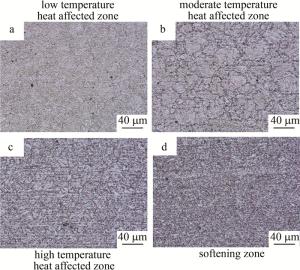
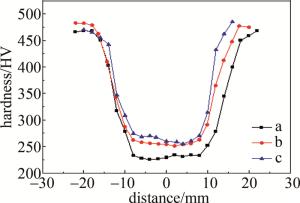
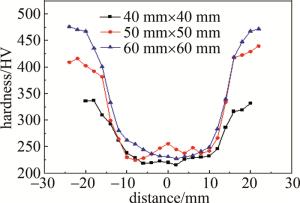
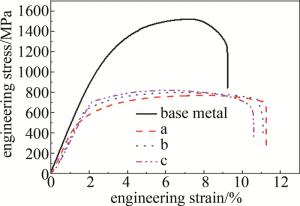

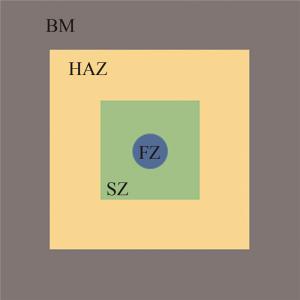

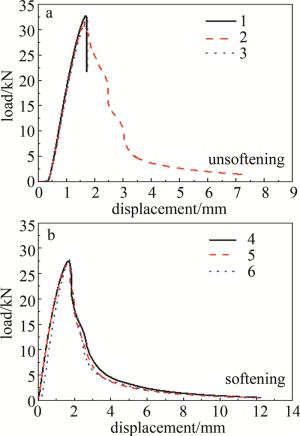
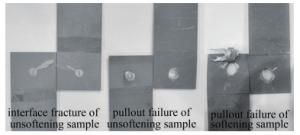
 DownLoad:
DownLoad:
